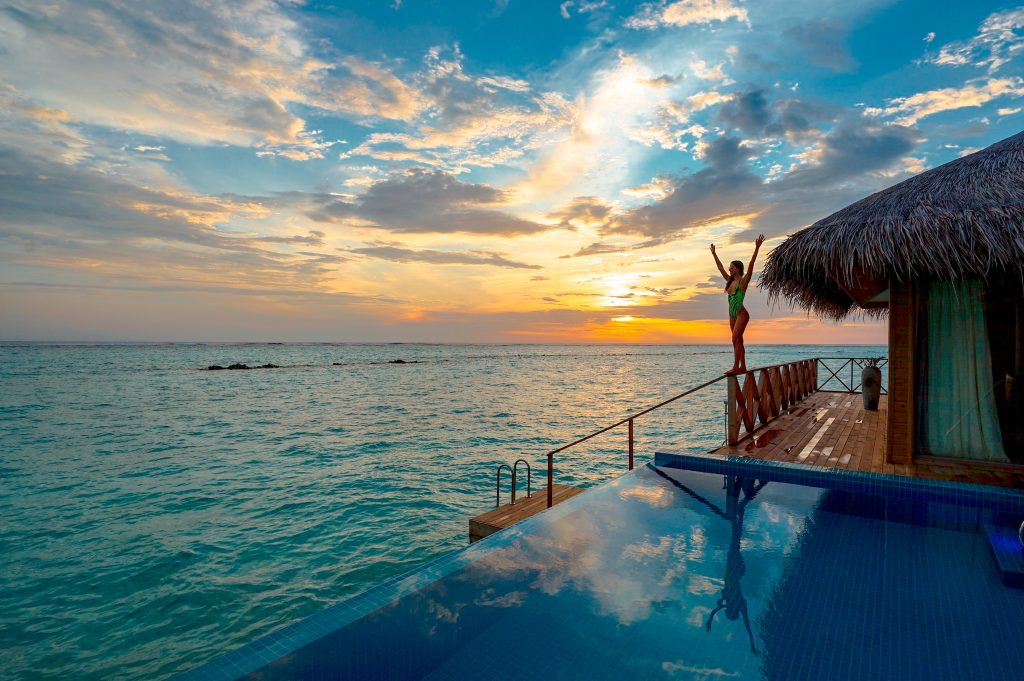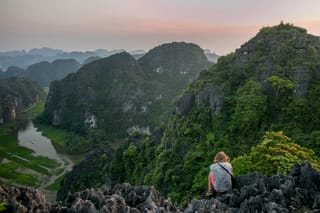
Imagine traveling to distant places, trying different foods, meeting new people, and documenting every new experience with your camera. Sounds like a dream right? For many, being a travel photographer sounds like a glamorous and exciting career path. But becoming one involves more than a nice camera and sense of wanderlust. It takes hard work, technical photography skills, a love of travel, and a unique photography style.
Travel photography is the art of capturing experiences in new places that allow the viewer to be transported to the experience along with you or convince your audience that a specific location is worth adding to their travel bucket list. These photographers are tasked with visiting new places and taking images that accurately represent the landscape, people, and experience.
With social media and online content being a staple in most of our lives, the demand for high-quality travel photography is on the rise. This type of photography is a broad term that encompasses many different sub-genres including:
- portrait photography
- landscape photography
- street photography
- food photography
- architecture photography
- wildlife photography
Now that you have a better idea of what travel photography is, the burning question on everyone’s mind is “how do I get started?” In this article, we’ll share our advice for how you can work to become a professional travel photographer. And check out our expert travel photography tips for additional details to jumpstart your career.
The Basics
What does a traveling photographer do?
A traveling photographer is paid to take pictures of different locations for travel-related content. If you truly love travel, that passion will also reveal itself in your photography. Traveling photographers experience new places and tell a story through photos of the landscape, locals, cuisine, and much more. It takes a person with a keen eye for storytelling to be able to paint the full picture for their audience and create memorable and emotional images.

Being a successful travel photographer requires that you enjoy (or at least can endure) the ups and downs of traveling including long flights, unexpected changes in plans, constantly unpacking and repacking, being immersed in a foreign language and customs, adverse weather, and lack of stability. It’s essential to accept the unpredictable nature of travel to make it in this field.
Is travel photography a career?
Yes! It takes time and dedication to make it your full-time job, but travel photography is an exciting and fulfilling career for many photographers. There is a growing market for content that can showcase a place’s unique offerings to future travelers, and travel photographers are more sought after than ever in our online world.
You can work as a freelance travel photographer and sell your work to different brands and companies, or you can work full time for a travel company or publication that partners with different places to promote travel and tourism. Many travel destinations including hotels, restaurants, or entire cities will pay top dollar to have high-quality images taken that may convince other travelers to visit.

How to Become a Travel Photographer
1. Set Concrete Goals
The first thing you should do is understand why this type of photography speaks to you more than another style. Establishing your “why” is a key component of understanding where your true passion lies.
Then, as with any career, it’s important to map out your goals. Work out some short-term goals for yourself with travel photography that you think you could accomplish in the next year. Do you want to work as a freelance photographer and pave your own way, or would you prefer the stability and consistency of working for an established brand?
If your ultimate goal is to work for a prestigious travel publication like National Geographic, map out the long-term steps it will take for you to get there. Set clear benchmarks and timelines to help keep yourself on track and know that you’re making progress.
2. Get the Right Camera Gear
Without the right gear, it will be difficult to reach your full potential as a travel photographer. What camera equipment you opt for will depend on your niche, but overall, some gear considerations to keep in mind for travel photography include:
- Size – If you’re on the move a lot, it’s important to have a compact camera option—also referred to as a “point-and-shoot” camera—on hand. If there’s room in your budget, mirrorless cameras are traditionally lighter and smaller than DSLRs and may be easier to travel with.
- Battery life – You’ll want to make sure you have the battery life you need to spend a full day out in the local areas taking photos. And of course, make sure you always have extra batteries and chargers handy.
- Versatility – If you are planning to photograph a location with different attractions, you may be dabbling in multiple types of photography (portrait and landscape, for example). It’s important you have multiple lenses as needed to capture the best images for each scenario. Zoom lenses offer easy adaptability and can provide you with more focal length coverage, helping you pack lighter than multiple prime lenses.

3. Broaden your Skill Set
Travel photography involves so many other types of photography that it’s important to have a broad set of skills and practice different forms to enhance your storytelling abilities and become more marketable.
If you excel in one form of photography, like portraits, practice taking more landscape or wildlife photos to expand your skills. Each form of photography demands different skills and details, so challenging yourself to leave your comfort zone is essential for any aspiring travel photographer.

Consider purchasing an online photography course from a photographer whose work you connect with and can learn from or joining online networks of photographers who can mentor you along your journey.
4. Identify your Niche
This tip may seem like the opposite of broadening your skill set, but both are important! Understanding where natural photography talents are is helpful for knowing where you will excel in travel photography. Is capturing human emotion important to you? Then photographing local stories on your travels might be your niche! If you love architectural photography, you may dive into taking general marketing shots of cities, hotels, and more. Identifying your niche will also help you to stand out in a competitive market.

Ask yourself these questions to help you narrow your focus:
- Which of my photos captures the emotion of travel photography?
- What types of photography do I believe help tell the story of a place?
- What are some of my top technical photography skills?
5. Build a portfolio
So you’ve traveled to some great places, taken beautiful photographs, and feel like you have a wide range of experience, now what? The next step is building a portfolio that showcases your unique talent. Your portfolio is what is going to get you hired or your photos purchased by brands.
Include photographs that capture your unique style as well as images that show your range as a travel photographer. Choose your best work then share photos with friends and family and see which resonate with them the most.

Make sure your portfolio is in a format that is easily shared and digested. Don’t go overboard with trying to include too many photos. Instead, choose 20-30 of your best images that really capture your style and create your portfolio. Consider having both an online portfolio and one in a format that can be printed and physically distributed. Update your portfolio regularly as you continue to improve and create.
6. Create a Website
Another important way to showcase your work is with a website or travel blog. A website allows you to showcase your work with additional context and stories around it. If you aspire to be a photojournalist, a website will allow you to publish your photos with content attached. Having a website will also help people find you organically when searching for different places online, allowing your content to get noticed!
Setting up a website is easier than ever with platforms like Wix, WordPress, and Showit. These web platforms are easy for anyone to design and display their work. Start with a few key pages like your homepage that describes what you do, your about page to share who you are, a gallery page, and a blog where you can add more context about your travels. Utilize SEO services or tools to help you identify keywords that will drive visitors to your site through search engines.
7. Use Social Media
Social media is an integral part of our daily lives and a great free way to get more eyes on your travel photography. Most photographers routinely use social media to share their work, especially channels with a visual foundation like Instagram or TikTok.
Getting started with social media for your photography can be as simple as creating a few accounts and showcasing your work as much as you can. It’s also a way to network and build connections with other photographers and brands. Provide value in your captions to foster trust and help gain followers who appreciate your work. Tips for creating a helpful social media strategy are:
- Curate your feed and choose images and captions that provide value
- Add relevant hashtags to reach a wider audience
- Experiment with videos and other types of content that tend to get high traction or engagement
- Connect with brands and professionals by commenting on and sharing their work and building a natural rapport
Some social media pitfalls to avoid include tagging brands and tourism companies that aren’t related to your post, expecting handouts or free perks, and forcing connections rather than showing a true interest. When used with intent and authenticity, social media can be a great tool for travel photographers!

8. Start Making Money!
Once you’ve honed your skills and built a portfolio, it’s time to start applying to gigs and making money! While it takes time to build your portfolio and create revenue streams, there are a variety of ways to go about making money from your photos while traveling.
Find clients
Work to build relationships with potential clients or brands who may be looking for travel photos, including:
- Businesses looking for promotional images like hotels, resorts, restaurants, rental companies, and more, and may be open to purchasing one-off photos or a photography package.
- Tourism boards who need visual content to market their destination to potential travelers. Start small and reach out to local tourism boards near you to showcase your abilities then branch out to more sought-after international organizations.

Check out online job postings for photographers or sites that advertise one-off jobs. Sites like Local Lens, LinkedIn, and Ziprecruiter may help you find part-time or freelance travel photography jobs.
Submit to magazines
Many magazines will accept submissions year round, while others will open up for public submissions periodically. Make sure you’re following travel magazines and blogs you admire online and keep an eye out for opportunities to submit your work. Take the opportunity to connect with them through social media when you can so that when you submit your work, you can follow up with them and they will hopefully have an idea of your brand and your work already.
When choosing what to submit, keep in mind the magazine’s overall aesthetic and style and choose your best images that are consistent with that style.

Sell prints
Another way to make money is to sell your prints. Consider having a storefront on your website or a third-party website like Etsy or Society6, where people can purchase prints. For travel photographers who specialize in landscapes or wildlife photography, selling prints can be a lucrative way to make extra money.

Some printing companies will even integrate directly with your website so visitors to your site can order prints that are immediately created and shipped to them without you having to facilitate the work. Promote the sale of your prints through social media or paid advertising.
Stock image libraries
Consider advertising your work on websites that sell and license stock photography. Popular sites to submit stock photos to are iStock, Getty images, Adobe Stock, Shutterstock, and Stocksy. Commission rates for stock photos range from 20-50% of the sales.
But remember that it’s crucial to understand how the website will be licensing your images for use before committing to selling your photos to them. Consider whether you want your photos used only for editorial purposes, or if you’re open to businesses purchasing them for commercial use.
Enter contests
Entering contests can provide great opportunities, both from a monetary perspective and the opportunity to win prizes including free trips, gear, free advertising, and more. Social media is a great way to find photography contests from accounts you follow. Or you can search online and keep track of any competitions that catch your interest and add the submission dates to your calendar.
Travel Photographer of the Year (also known as TPOTY) is one of the most popular photography contests and has helped many travel photographers gain recognition and propel them to successful careers in the industry.

Get Started on Your Travel Photography Career Today
Travel photography can be a fun but challenging career path. The advice shared above can get you started, but the best way to work toward your dream of becoming a travel photographer is to get out there and experience! Start small with local trips and practice honing your technical photography skills. Once you feel your work is in a good place, start partnering with brands and publications to monetize your passion. And remember that your success isn’t defined by worldwide recognition or thousands of social media followers; as long as you love your career, travel photography can be a fulfilling long-term career!
Get started today with high-quality travel photography gear to help you create beautiful and meaningful images. Save money where you can by purchasing high-quality used cameras and lenses that are perfect for travel.




